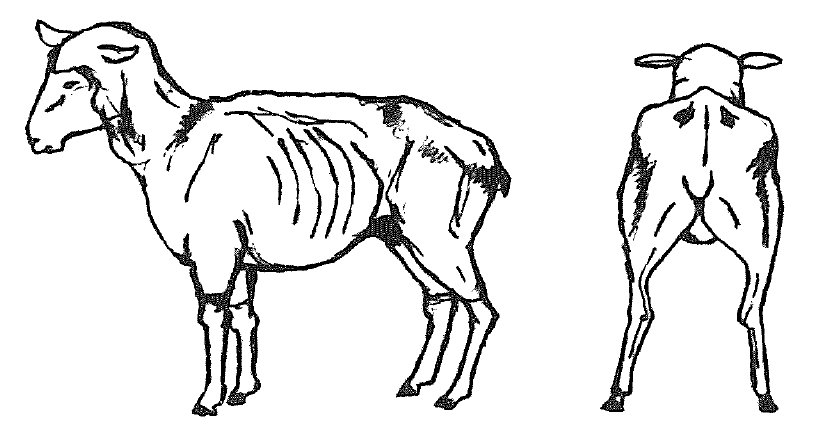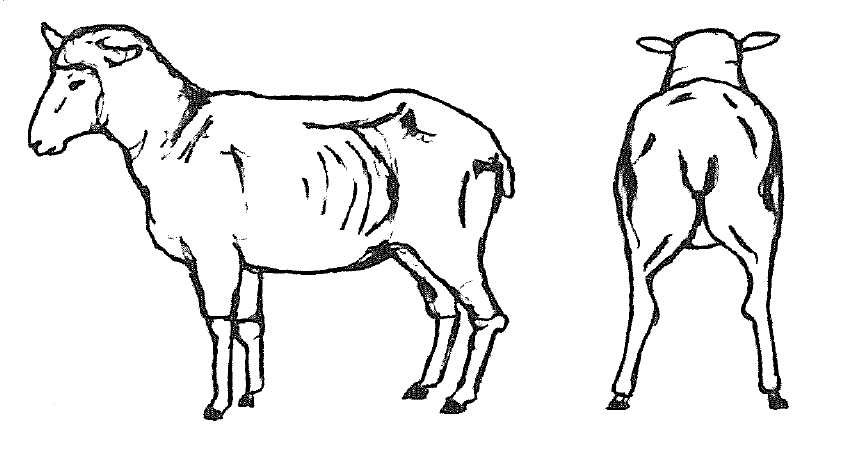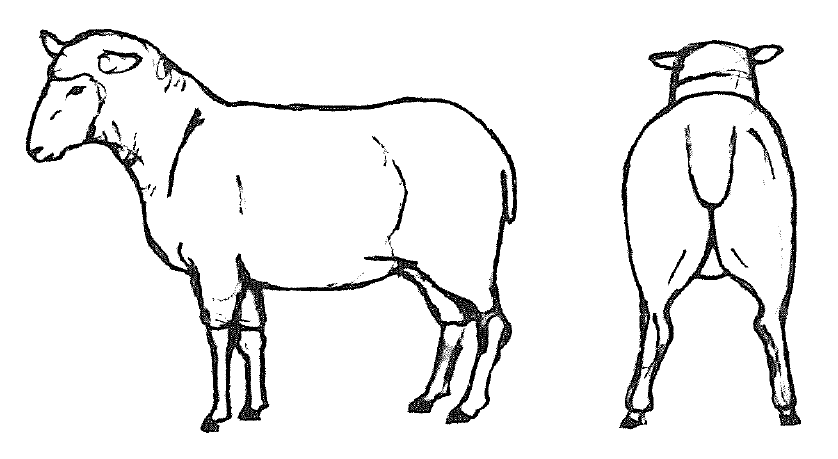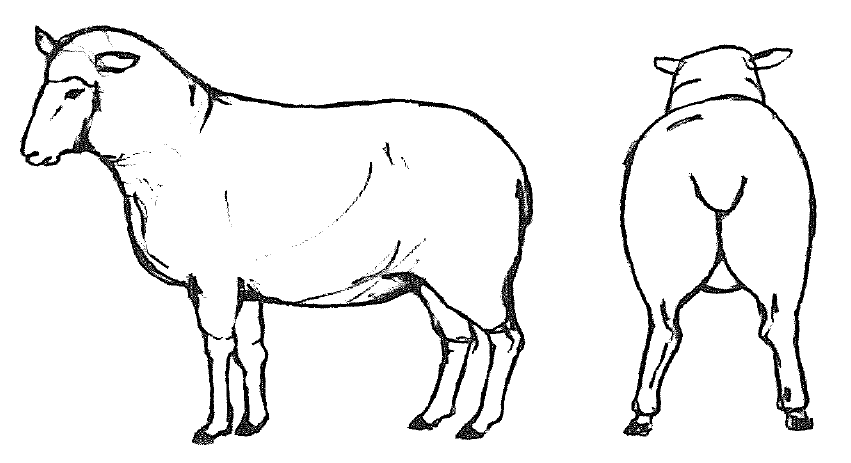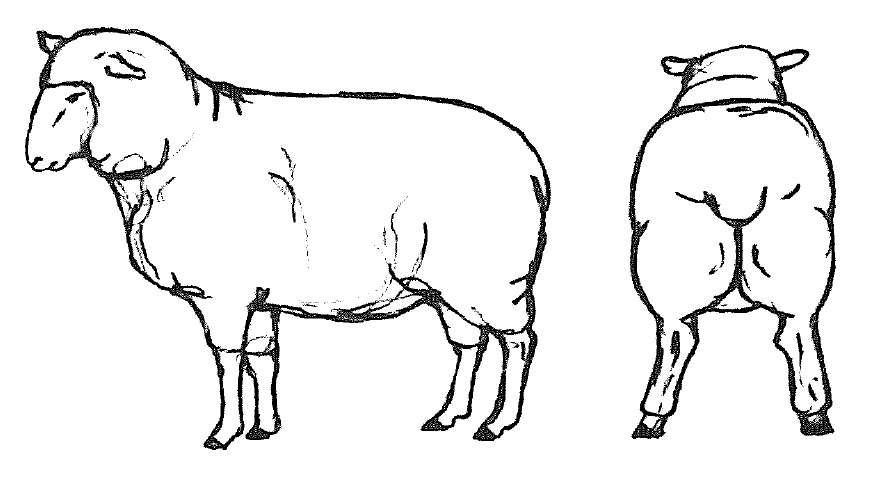Feeding sheep
All animals need adequate nutrition to maintain health. Sheep with poor pasture or little pasture will lose weight and body condition. Animal owners have a duty of care to provide adequate nutrition and clean drinking water. If your pasture can't supply the required nutrition, sheep will need to be supplemented or fully hand fed.
A sheep's body condition can be scored on the following scale:
- Poor
- Moderate
- Good
- Fat
- Very fat
Once a sheep reaches a condition score of 2 (Moderate), it will need feeding to maintain health and return to an optimum condition of 3 (Good).
Body condition score 1 (Poor)
- Appearance angular and narrow
- Backbone raised and sharp
- Hollow behind ribs
- Tail feels bony
- Neck bones prominent
Body condition score 2 (Moderate)
- Backbone raised but smooth
- Ribs are easily felt
- Tail bone easily detectable
- Thin neck
Body condition score 3 (Good)
- Backbone slightly raised
- Ribs smooth, can just be felt
- Tail bones barely detectable
Body condition score 4 (Fat)
- Appearance well rounded
- Backbone can just be felt
- Ribs are covered
- Tail firm and rounded
Body condition score 5 (Very fat)
- Appearance very well rounded
- Backbone barely detectable
- Ribs cannot be felt
- Tail fat and broad
If sheep have a fleece, feeling along the back bone and short ribs will give you an indication of the fat cover they may have. If you can easily feel the backbone and end of the short ribs the sheep will need feeding.
Knowing the weight of your sheep and goats is a good guide to their dietary requirements for maintenance.
Sheep will eat 2–3% of their bodyweight each day, although younger sheep or ewes with lambs can eat up to 4%. Generally, the best option for feeding sheep and goats in drought is grain but there is no advantage in crushing the grain for sheep. You can feed corn out on the ground but all other grains should be fed in troughs. Allow one metre of trough space for every six sheep.
When sheep are not eating any dry paddock feed, they should be 'conditioned' to grain-feeding to avoid digestive upsets. Start by feeding a small amount of grain mixed with chaff, hay or other roughage for 4–7 days and increase the amount of grain gradually over similar periods until they are receiving a full grain ration.
You should also lessen the frequency of feeds gradually. During the first and second periods feed sheep daily, then introduce intermittent feeding. By the fifth or sixth period, put the feed out once every 3–4 days.
-
Costs of feeding sheep and goats
Cost of feeding sheep and goats
Feed prices current at 20 January 2020Class of sheep
Feed
Amount needed
per week (kg/hd)Cost per
week ($/hd)45 kg ewes in lamb early stages
wheat
3.8
1.79
or oats
4.6
2.30
or hay (good)
5.4
4.86
or hay (poor)
7.0
4.90
60 kg ewes in lamb 4–6 weeks before lambing
wheat
6.2
2.90
or oats
7.0
3.50
plus hay (good)
1.5
1.35
or hay only (good)
10.0
9.00
60 kg ewes with lambs
wheat
9.0
4.27
or oats
11.0
5.50
plus hay (good)
2.0
1.80
or hay only (good)
14.0
12.60
Lambs 15 kg +
wheat
2.0
0.95
or oats
2.3
1.15
plus hay (good)
3 + grazing
2.70
or hay only (good)
4.5
4.05
Costs are based on wheat $475/t, oats $500/t, lucerne hay $900/t and cereal hay $700/t landed.
Adapted from: Drought feeding and management of sheep (2018)Sheep and goats can be supplemented with many pelleted feeds. Depending on the analysis of the pellet, consumption rates will vary and often roughage is required. Current costs for these pellets is in the vicinity of $500/t. Check with your supplier to determine correct feeding rates for their product.
Water
Sheep and goats will drink 6 litres (L) a day for a weaner, 10L for an adult dry sheep and 14L for a ewe with a lamb. These figures are for summer and the amount will vary depending on the moisture content of the feed. The salt content of water needs to be below 3,800ppm for weaners, but older sheep can tolerate up to 6,400ppm.
Forecasting pasture
In the subtropics, summer rainfall largely determines how much pasture grows before the end of the pasture growing season, in autumn. Higher or lower summer rainfall gives higher or lower pasture yield for carrying stock for the year ahead. For most graziers, the paddock feed and water supplies available in April or May have to last until next summer. Many graziers comment on the benefits of moving early in the year to adjust stock numbers according to pasture supply.
Generally the aim is to let stock eat about 30% of the useful feed which is available at the end of the summer growing season (or 15–20% in low rainfall environments).
For example, if there is 3,000kg dry matter per hectare (ha) of useful pasture, then 30% x 3,000kg = 900kg of useful feed per hectare. If a cow eats around 9kg of dry matter a day, then there is about:
- 100 days grazing per 1ha
- 200 days grazing per 2ha
- 365 days grazing per 3.65ha.
It is ideal to do these dry season pasture budgets each autumn to adjust stock numbers according to pasture availability. Winter rain may grow some high moisture, high quality herbage but usually not a significant bulk of dry matter feed.
